

|
Back to |
| The Front Page |
| News & Features |

|
The Era of the Composition Balls Ends with the Demise of the Jaques "Eclipse"
by Bob Alman Posted September 3, 1997
|
Although the one-piece plastic ball has slowly gained the lion's share of the market over the last decade, Jaques' announcement that the venerable company would discontinue manufacture of their "Eclipse" following a June fire in their London factory has come as a shock to die-hard fans of the last surviving composition ball. Now the question is: Which plastic ball will fill the vacuum - the widely popular Barlow GT, a new plastic ball Jaques claims to have been in development for several years, or some other superior plastic ball out there waiting to find a market?
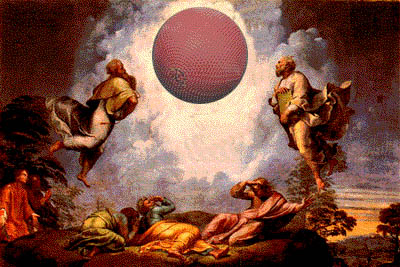
|
| The incomparable Jaques Eclipse - the favorite of several generations of croquet players - has passed into history, the last of the composition balls. |
It was, perhaps, the most shocking news to hit the croquet world since the Ayres company made a similar announcement following World War II that it would not resume manufacture of croquet equipment. This meant that the Ayres Championship ball - almost universally preferred over all its competitors - would no longer be available.
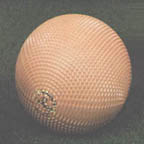
|
| It looks very much like its plastic imitators, but this Eclipse is a ball with soul, with multi-layered character, and if you crush it's crisp surface, it will crack, chip, or peel. Under the heat of the midday sun, the black ball may even absorb enough energy to cause it to explode. |
History may be repeating itself. Jaques has reportedly informed the present day Council that their new plastic ball, in development "for five or six years" will be available for testing by the Croquet Association in October.
Why such haste? Because new orders must soon be taken for the 1998 playing season in the Northern Hemisphere, and if there are Eclipse balls to be replaced, manufacturers must be able to promise delivery by early spring at the latest. If Jaques does not have a suitable product available by then, the vacuum will be filled by a competitor, and the opportunity will have been lost Associations and clubs will not change their stocks of balls without very good reason. It's too expensive.
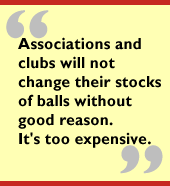
News of the fire apparently did not reach the croquet community until at least six weeks after the event. One can only imagine the crisis atmosphere at Jaques as management deliberated its choices - all of them unappealing. Basically they boiled down to the choice between... (1) undergoing a difficult and expensive re-tooling process and resuming manufacture of the Jaques Eclipse as soon as possible; or (2) Biting the bullet, declaring the Eclipse dead in a market that was gradually shrinking anyway, and gambling on producing and marketing a competitive plastic ball.
The official announcement from Christopher Jaques
The "official story" of this affair is the announcement of Christopher Jaques published in the September/October issue of the English CROQUET GAZETTE, as follows, courtesy of Gail Curry, editor:
"John Jaques, manufacturers of the Eclipse ball, suffered a fire three months ago which unfortunately destroyed not only stocks of the ball, but the machinery used to create them. After lengthy consideration, Jaques have decided not to pursue production of the Eclipse ball by attempting to replace the machinery, but will instead be replacing the Eclipse with their own solid, one-piece ball.This ball has been developed and tested over the past five or six years and will shortly be available on general release. Several sets of the prototype ball have been on test with international players overseas, and those that have used it have reacted very favorably, comparing its playing characteristics to those of the old Eclipse ball."
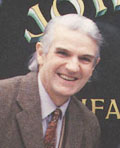
|
| Christopher Jaques of John Jaques & Sons, Limited |
The biggest puzzle is the origin and lineage of the Jaques plastic ball. How new is it, really? Or is it the poorly received Jaques "XLP" tested in the United States by Jack Osborn (who died in early 1996) and sold through Croquet International Limited's 1995 catalog? The catalog copy says the XLP "does not quite match the...playing excellence of the world standard Eclipse, but it clearly comes the closest to date" of any one-piece plastic ball yet produced. But priced competitively at $170/set, it still didn't sell. CROQUET WORLD could find no one who uses the ball and thus no reliably objective report on its playing characteristics. It was not submitted for testing to the English Croquet Association, and apparently its existence was unknown until now to members of the English Council.
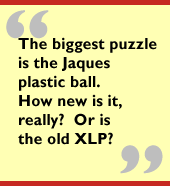 Croquet International Ltd., the Osborn company which is still the authorized
Jaques distributor in the United States, says it will again offer the ball in
its 1998 catalog. The company representative could not say why the ball
was dropped in 1996-97.
Croquet International Ltd., the Osborn company which is still the authorized
Jaques distributor in the United States, says it will again offer the ball in
its 1998 catalog. The company representative could not say why the ball
was dropped in 1996-97.
Why was the XLP not tested by the English Croquet Association - which also serves as the official tester for the World Croquet Federation? Why was the XLP tested only in the United States by Jack Osborn, the authorized U.S. Jaques distributor? Is the ball to be tested by the CA in October the XLP, or a revised or improved version?
We have addressed these and other questions to Jaques, and no answers thus far are forthcoming.
Pidcock asked to prepare new ball testing procedures
Coincident with the Jaques disaster, Alan Pidcock, developer and manufacturer of the much-praised Pidcock carbon-shaft mallet and an expert on the characteristics of croquet balls, was asked by the English Croquet Association Equipment Committee to prepare new and improved testing procedures for croquet balls. Up to now, the main test for a croquet ball is the "bounce test" of balls on a steel plate. If the height of the bounce falls within the accepted range, the ball is deemed to pass muster and may be approved by the CA for use at sanctioned events and may be certified and licensed by the World Croquet Federation.
Pidcock is the keeper of an extensive archive on ball testing, and until his recent retirement was a Professor of Chemistry at the University of Lancashire (Preston.) Under his direction his final year engineering students conducted detailed comparative studies on the Jaques Eclipse and the Barlow. These studies isolated numerous characteristics for testing - not just the bounce height. Although the studies have not been published, enough of their conclusions have been leaked to convince the Council that more sophisticated testing procedures need to be developed.
For many decades, the playing characteristics of the Eclipse have been assumed to be the ideal for a croquet ball. A new ball could find a niche in the market only to the extent that it was similar to the Eclipse. (For example, the "correct" distance ratio of the struck ball and the croqueted ball was determined only because that's what happened when you played the stroke using Jaques balls. If other balls did not produce the same ratio, they were "wrong.) The death of the Eclipse provides an opportunity to develop more objective testing standards.
Why Jaques clears hoops more easily than Barlow
Pidcock cites "the moment of inertia" as an example of specific significant characteristic of balls which could usefully be tested and compared. Recalling that he might be the only person to have cut a Barlow in half, he describes a space of about one inch in diameter in the middle. In the manufacturing process one pound of material is placed inside the mold and then is centrifuged towards the outside, creating the hollow center. The Jacques Eclipse, on the other hand, though layered, is solid, consisting of a solid core, a layer of compressed cork, and the outer plastic coating. With more of the mass distributed towards the rim, the Barlow has a longer "moment of inertia" - that is, it will tend to skid along the ground for a longer period before beginning to roll.
"This rotational momentum is quite important in hoop running if the ball makes contact with the uprights," Pidcock observes. "The Barlow will be more 'difficult' in hoop shots than the Jaques, which has greater rotational momentum. I should emphasize that these differences, though measurable, were quite small. Other tests - for example on surface deformability - could reveal still other differences."
Council offers Professor Pidcock to Jaques as consultant
The Croquet Association has offered to make Professor Pidcock available to Jaques as a consultant in their attempt to produce a plastic ball with Eclipse-like characteristics. The Croquet Association made this offer to Jaques before it was known that Jaques had already produced a plastic ball and had attempted to sell it in America. According to Pidcock, Jaques has not contacted him in response to the offer.
This is not the first time the Croquet Association has extended itself to encourage the development and production of superior balls. In the early eighties, when Jaques suffered a radical decline in quality control - it was rumored that the only person who could make the balls was in prison - there was virtual panic in the quest for a suitable replacement.
The Eclipse at its lowest ebb in the mid eighties
The manufacturing glitches were eventually corrected, but Richard Hilditch recalls the era in the 80's when the Jaques balls were at their worst. "We would typically get splits of a quarter of the balls with only two years of use, even though the old balls would go on for years (although gradually wearing and getting smaller and lighter). This came to a head around 1983 when about 50 percent of all new balls would split during the first day's play.
"At one open championships," Hilditch recalls, "we ritually presented to Charles Jaques (then chairman of the company) a black ball that had grown to an egg shape measuring 4 1/4 inches in the largest dimension. We had left it in the sun to grow after it went out of round. He was not amused."
"By 1986 the Jaques balls were a bit better but still liable to crack and tending to deform - getting bigger, smaller, or out of round. Traveling around the country with the MacRobertson, we would take the balls at lunch and put them under chairs to give them shade."
The Council encourages development of alternative balls
In this period when Jaques quality was at its lowest ebb the Croquet Association encouraged the development and use of the Walker and Birkdale balls.
The Walker was extremely bouncy and so very different from the Jaques that it did not long survive because no one would play in the events using the balls. The Birkdale (developed at Southport) fared better and is still occasionally used, though production ceased a few years ago. It was bouncier than the Jaques, with good rushing action, but it was more difficult to make the back ball advance in the croquet shot. As a good ball that was nonetheless not widely accepted, the Birkdale proved that to find market acceptance, any new croquet ball would have to perform similarly to the Jaques Eclipse.
Nevertheless, Jaques has not achieved a monopoly in Britain, where tournament producers exercise free choice of a variety of approved balls. Richard Hilditch researched the balls announced for 1997 tournaments in Britain and found that Jaques was the choice of slightly more than half, with Barlow (either XT or GT) a strong second place, and a few events using Birkdale or Dawson balls.
If a new Jaques plastic ball doesn't make it through the testing process, there are still two balls to choose from which are - in addition to the Eclipse - approved by the CA and licensed by the World Croquet Federation: The Barlow GT (manufactured in South Africa, the officially approved ball of the United States Croquet Association and currently the most popular plastic ball worldwide) and the Dawson 2000 (Mark 2), manufactured in Australia and with its core market on that continent.
Waiting in the wings: the American-made "Ultimate" ball
A fourth ball met the testing standard and was granted a three-year license in 1994 by the WCF - the "Ultimate" ball, of American manufacture. The Ultimate could find no market niche, however, and the developer could not generate sufficient orders to merit its continued production. It's WCF license lapsed on May 31, 1997. Since it has already passed the test, its license could be renewed.
Contacted by phone at his home in Rutherford, North Carolina, David Blender, the chemist who developed and manufactured the Ultimate, told CROQUET WORLD that he does not have current stocks, but that all his equipment is available, and he could produce substantial new stocks within two months of startup. Blender is confident that his formula has produced the ball with the best playing characteristics of all his plastic competitors. Minor early problems with milling and color blends have been solved, he says. When asked about the negatives of the Ultimate, he acknowledged that he has not produced a ball with a color-fast stripe - the stripes have to be painted on, unlike the Barlow, whose stripe is molded and laminated in place.
(Memo to Jaques: Instead of rushing into production a new and untested ball, why not buy the rights of the already tested and approved Ultimate?)
Jaques juggles remaining inventory of Eclipse balls
Although Jaques' "official account" of the fire suggests that the existing stocks of Eclipse balls were destroyed in the fire, that is clearly not true, as favored customers and distributors are still receiving large orders and in some cases being promised further shipments. The precise extent of these stocks is unknown and will doubtless not be revealed by Jaques, who must take care of their best customers and do what they can to preserve their market share.
One potential customer in Britain was recently told by Jaques, "We can't supply the balls. We don't even have enough to fill an 80-set order from New Zealand." But we checked with New Zealand and learned not only that their 80-set order has arrived, but also that Jaques has assured the NZ association that a further large order will also be filled - and that the New Zealand Association will soon receive a new plastic ball for testing.
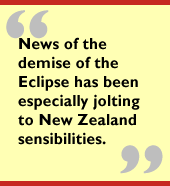
Nevertheless, the news of the demise of the Eclipse has been especially jolting to New Zealand sensibilities. The Kiwis treasure tradition, and they dislike change. They will have to change, but they're unhappy about it. They don't like either of the plastic balls currently licensed - from South Africa and Australia. New Zealand is Jaques' biggest Eclipse customer. Perhaps it will be the first Southern Hemisphere country to go with the new Jaques plastic ball - in the name of tradition.
Prospects for a new Jaques plastic ball in the United States are less promising. The Barlow has achieved wide acceptance already as the officially approved U.S.C.A. ball. The molded-in striping is an especially strong selling point in Barlow's favor in North America, where second colors are seldom used because of the confusion this causes in the American Rules games, involving sequenced play of the four balls and deadness boards. Painted-on stripes are not popular, as they quickly wear off and must be refreshed by hand.
Ironically, the passing of the Eclipse will help to resolve a "player revolt" brewing in the Eastern U.S. by Eclipse advocates who opposed the official switch to Barlow and were determined to insist on a return to the traditional composition ball at all costs.
Barlow likely to achieve virtual monopoly in America
According to Canadian distributor Don Oakley of Oakley Woods, Christopher Jaques told him in a phone conversation around the first of August that the fire did not affect the inventory. Nevertheless, Oakley's customers have already started the shift from Jaques to Barlow, although, he says, he has ample stocks of Eclipse balls on hand now, ready to ship. "But the Barlow is the official U.S.C.A. ball, and players need to be familiar with the ball before they play in U.S.C.A. sanctioned events." Oakley also has plenty of Barlow stock read to ship, he says, in first colors, second colors, and stripes.
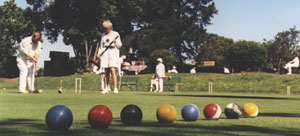
|
| Barlows in a row: There's a blue one, and a red one, and a striped one and a yellow one, and they all have uniform dimensions, and they all behave just the same. |
Australia is loyal to its native Dawson, America and South Africa have been captured by Barlow. Europe is a growing market for croquet equipment and may be expected to follow the lead of Britain.
Egypt doesn't need a WCF approved ball to play Egyptian Golf Croquet, their national form of the game. The W.C.F. has approved for use at the Golf Croquet Championship in Cairo in October the Egyptian-made ball, which does not meet the bounce test - but according to Chris Hudson, "There has been some discussion about the need for this in Golf Croquet, where the croquet shot is not used. The W.C.F. has decided to sanction the use of Egyptian balls for the Golf Croquet Championships so that players' reaction can be assessed prior to a decision whether or not to apply the existing standards for championship balls to golf croquet events."
That leaves only Britain and New Zealand among the major players to decide the fate of the new Jaques plastic ball.
History and tradition favor Jaques' survival
In Jaques' favor in their quest for these markets is a love of tradition - in England, in New Zealand, and at Jaques. The company successfully produces equipment for many games and sports. Their motto is, "We taught the world to play croquet." And indeed, they did.
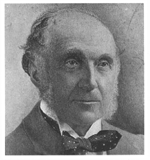
|
| John Jaques II was not the founding patriarch of his company - he was the third of six generations - but he was one of the most creative entrepreneurs of the Jaques line, and he is credited with establishing croquet as a popular pastime in Britain in the1860's. |
The Jaques firm was the first to make croquet equipment as a regular line of business. Their first balls were one-piece wooden carvings, which were the standard until the early days of the 20th Century, when boxwood went out and the composition ball came in. Jaques is the only survivor of that era, having been passed down through six generations from father to son.
For beauty and craftsmanship, their products are unsurpassed. If their London factory looked to an American visitor in the early 1990's "dark and dingy, like something out of the 19th Century," it's only what one would expect of a company that sells worldwide and still, in 1997, does not have computers or E-Mail. (There was great resistance a few short years ago, it is said, to installing a fax machine.)
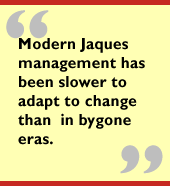
The truth is that modern Jaques management has been slower to adapt to change and respond to competition than company management in bygone eras. In World War II, for example, the Jaques factory was leveled in the blitz. Nothing remained except a pattern-book from which every game Jaques produced could be reconstructed. Only factories essential to the war effort were authorized by the beleaguered British on their fortress island. Nevertheless, in the midst of the blitz, Jaques rebuilt and resumed production.
The resumption of Jaques manufacturing during the war was explained only after the Nazis had been defeated. Jaques, it seemed, in league with British intelligence, had contrived to build into their games secret compartments concealing hacksaws, maps, and currency - contraband which British prisoners of war could use to escape from prison camps. Games were among the items allowed under the Geneva Convention of 1929 to be sent to prisoners of war, and Jaques craftsmen excelled in their concealing of escape kits in their games. The ploy was never detected by the Germans.
Why weren't the Germans suspicious of a company manufacturing games when the British allowed only "essential war industries" to operate? Perhaps, as the official Jaques history says, "they chalked it up to the renowned eccentricity of the British, to whom games and sports have always been serious business!"
But Jaques management did not take seriously enough the introduction of the one-piece plastic ball in the 80's, which has gradually improved through many generations. They did not start soon enough to develop a plastic ball that could compete.
After thus "dropping the ball," it seems unlikely that the company will ever recapture the largest share of the croquet ball market. But if Jaques can quickly produce a decent plastic ball that will pass the critical bounce tests and sell at an affordable price, they can at least stay in the game.
As for the game, the passing of the Jaques Eclipse will not harm it, and indeed may even been a boon to the sport, making possible a greater uniformity of standards than could ever have been achieved with two distinctly different types of balls sharing the market.
Most croquet players will miss the beautiful, delicate, and temperamental Jaques Eclipse, its crisp action, the bright THWACK! of its roquet. But as one unusually progressive New Zealander commented, "It doesn't really matter to the sport what kind of ball is used, so long as it is round."
[This is only the first chapter of our story. .CROQUET WORLD ONLINE MAGAZINE welcomes news of further developments from all sources as we seek to answer the remaining questions in a second report. Send your E-Mail to the editor at: bobalman@aol.com.]